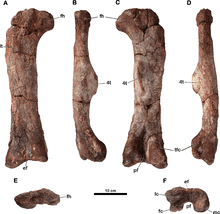Meroktenos
Meroktenos is a genus of basal sauropodomorph dinosaur that lived during the Late Triassic of Lesotho.
| Meroktenos | |
|---|---|
 | |
| Right femur | |
| Scientific classification | |
| Kingdom: | Animalia |
| Phylum: | Chordata |
| Clade: | Dinosauria |
| Clade: | Saurischia |
| Suborder: | †Sauropodomorpha |
| Clade: | †Anchisauria |
| Genus: | †Meroktenos Peyre de Fabrègues & Allain, 2016 |
| Type species | |
| †Meroktenos thabanensis Gauffre, 1993 | |
Discovery and naming

In 1959, François Ellenberger, Paul Ellenberger, Jean Fabre and Leonard Ginsburg discovered the type specimen, a thighbone or femur and other assorted bones, south of the village of Thabana Morena. In 1962 these were addressed in a thesis by D. Costedoat.[1] The exact location the bones were recovered, is today unknown.[2]
In 1993, François-Xavier Gauffre assigned the remains to a second species of Melanorosaurus: Melanorosaurus thabanensis. The description was provisional, and in 1997 the fossil was described in more detail in a publication by Jacques van Heerden and Peter Malcolm Galton. The specific name refers to the site Thabana-Morena in Lesotho.[3]
Gauffre assumed that the specimen had been found in the Upper Elliot Formation dating from the Hettangian-Sinemurian and thus was about twenty million year younger than Melanorosaurus readi.[3] In 1996, he revised the date to the Lower Elliot Formation of the late Triassic in his non-published dissertation. He also referred the thighbone to a new genus and species Thotobolosaurus. This remained a non-valid nomen ex dissertatione, as the name would never be published; furthermore the type material of this species does not coincide with that of M. thabanensis.[4]
In 2016, M. thabanensis was appointed to the separate genus Meroktenos by Claire Peyre de Fabrègues and Ronan Allain. The genus name is a combination of ancient Greek μηρός, meros ("thigh") and κτῆνος, ktènos ("beast").[2] The combinatio nova thus becomes Meroktenos thabanensis, the type species is the original Melanorosaurus thabanensis.
The holotype, MNHN.F.LES 16, consists of a right thighbone (MNHN.F.LES16c), a portion of the right ilium, with a piece of a vertebral neural arch (MNHN.F.LES16a); a left pubic bone (MNHN.F.LES16b); and a second right metatarsal (MNHN.F.LES16d) associated with the skeleton. In 2016, a new specimen, MNHN.F.LES351, was referred to the species; consisting of a cervical vertebra, a left ulna and a, probably left, radius. It might have belonged to the same individual as the holotype, but this cannot be strictly proven.[2]
Description

Meroktenos has a femur length of around forty-eight centimeters,[2] suggesting a body length of about four meters.
In 2016, a revised list of distinguishing traits was given. The blade height of the ilium, measured from the highest point of the antitrochanter to the upper edge of the blade is 60% of the total height of the ilium, including peduncles. The rear blade of the ilium is roughly triangular in side view. The femur is very compact with a robusticity index, length divided by the circumference of the shaft, of 2.09. The femur has a straight shaft in both side and front views. The femoral shaft is substantially wider transversely than it is wide in side view, with a ratio of 1.58. On the rear of the femoral shaft, the fourth trochanter is oriented obliquely, running from the upper and inner side to the lower and outer side.[2]
Phylogeny

In 2016, Meroktenos was placed in the Sauropodomorpha, in a basal position. According to a cladistic analysis, Meroktenos formed a polytomy with Blikanasaurus and more derived species, above Aardonyx in the evolutionary tree and below a polytomy including Melanorosaurus and Antetonitrus.[2]
Palaeobiology
The relative transverse width of the femur, the eccentricity, is remarkably high for such a small animal. These proportions were known previously only from Sauropoda and explained as an adaptation to a very high absolute weight. Because the holotype probably was not a young animal and is unlikely to have attained giant proportions, the trait must have had a different function.[2]
See also
Notes
- Costedoat D., 1962, Etude de quelques reptiles fossiles, thesis, University of Paris
- Peyre de Fabrègues, C; Allain, R (2016). "New material and revision of Melanorosaurus thabanensis, a basal sauropodomorph from the Upper Triassic of Lesotho". PeerJ. 4: e1639. doi:10.7717/peerj.1639. PMC 4741091. PMID 26855874.
- Gauffre, F-X (1993). "The most recent Melanorosauridae (Saurischia, Prosauropoda), Lower Jurassic of Lesotho, with remarks on the prosauropod phylogeny". Neues Jahrbuch für Geologie und Paläontologie. 11: 648–654.
- Gauffre F-X., 1996, Phylogénie des dinosaures prosauropodes et étude d’un prosauropode du Trias supérieur d’Afrique australe Dissertation, Muséum National d’Histoire Naturelle












